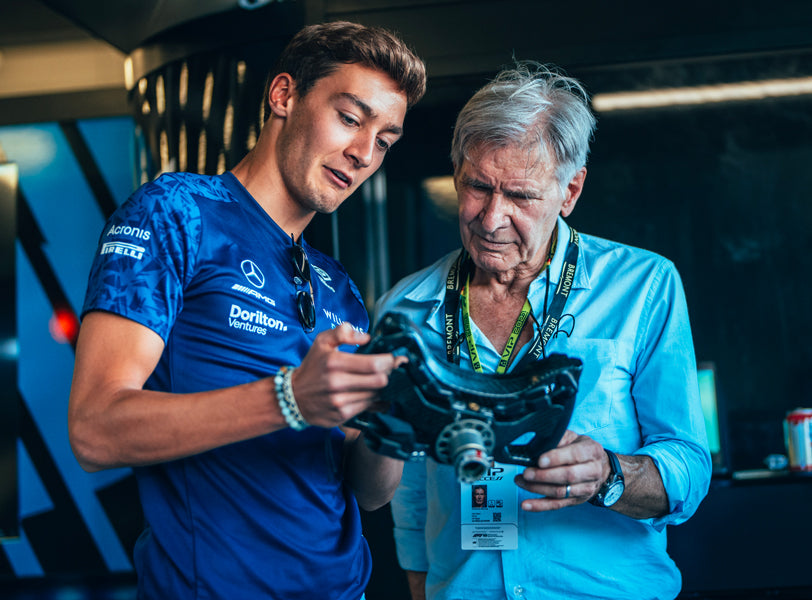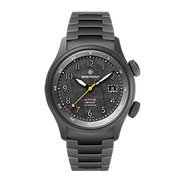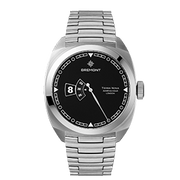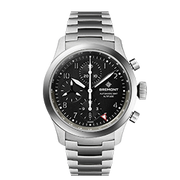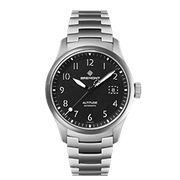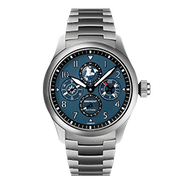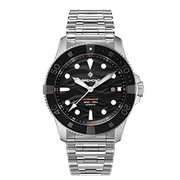Frequently asked questions
-
ARE ALL BREMONT WATCHES CHRONOGRAPHS?
Not all Bremont watches are chronographs. Those that are have a stopwatch function and include: ALT1 models, Boeing 247, Jaguar MKII, DH-88, P-51, EP120, Victory, Codebreaker and 1918.
-
HOW DO I FIND MY NEAREST AUTHORISED DEALER?
Follow the “Store Locator” tab on the home page, then the “Authorised Dealers” tab will lead you to the right information.
-
HOW DOES A MECHANICAL WATCH WORK?
A mechanical watch is driven by a wound spring held inside a barrel. As it unwinds, the spring causes the barrel to turn, driving a train of wheels. The speed of rotation is controlled by the escapement, which is made up of the escape wheel, pallets and balance. As the balance oscillates it moves the pallets from side to side, releasing one tooth of the escape wheel at a time, providing the impulse to keep the balance oscillating. The turning escape wheel sets off a train of other wheels one of which ultimately has the hands of the watch connected to it so that they are turned by the movement of the wheels.
-
HOW LONG DOES SUPER-LUMINOVA® LAST?
The luminous effect of Super-Luminova® lasts for several hours at a time.
-
WARRANTY
BREMONT INTERNATIONAL WARRANTY
The following warranty applies to watches sold by Bremont directly or through a Bremont Authorised Retailer only.
All Bremont timepieces have been hand assembled at the Bremont watch making facility in Henley-on-Thames, England. Each watch has undergone strict quality control and testing procedures by our highly skilled Bremont watchmakers.
Should you experience an issue with your Bremont watch, please contact your Authorised Retailer to arrange for your timepiece to be sent to a Bremont Service Centre. Only Bremont Authorised Service Centres are entitled to perform service and warranty work for the purposes of this warranty. Any work undertaken by a non-Bremont authorised agent will invalidate this warranty.
Your Bremont watch is covered under warranty against manufacturing defects for 3 years from date of original purchase. In order for work to be carried out under warranty, you will be required to present, with your Bremont watch and an explanation of the alleged defects, the duly completed, dated and stamped (by the Authorised Retailer at the time of original purchase) warranty card that relates to your Bremont watch. You are responsible for any transportation costs, including but not limited to postage, packaging materials and insurance in returning your watch for repair. After warranted works are completed, your watch will be returned to you at Bremont's cost.
In the event that, following receipt of your watch, the required works are not covered by this warranty, you will be contacted and a quote for undertaking any required repair or other work will be given to you. You will be responsible for such costs and, in those circumstances, the costs incurred in returning the watch to you whether or not such works are subsequently undertaken at your request.
The warranty does not cover straps and clasps or defects and damage caused by:
Theft, loss, fire or damage through natural causes;Deliberate misuse, negligence or accidents;Improper use (knocks, dents, scratches etc.)Repairs/servicing not provided by an Authorised Bremont Service Centre;Regular wear and tear.
For the Bremont International Warranty to remain valid, service and warranty work must be carried out by an Authorised Bremont Service Centre. Work carried out by other parties will result in the warranty being invalidated.
In order to ensure that your Bremont mechanical timepiece is running to its full potential for years to come, it will require regular maintenance and Bremont advise that you arrange a full service by an authorised Bremont Service Centre, every 3 to 5 years and the costs of such servicing work are not covered by this warranty but all such servicing works are separately warranted at the relevant time.
For more information on your Bremont mechanical timepiece, please refer to the technical notes given to you at the time of your original purchase of your watch.
Watch Servicing
To send your watch to Bremont for servicing or repair please contact your nearest Authorised Dealer , Bremont Boutique or Bremont Service Centre (servicecentre@bremont.com). For any other service or repair enquiries, please contact us using our contact form.
Bremont Watch Company
Manufacturing and Technology Centre
The Wing
Reading Road
Henley-on-Thames
Oxfordshire
RG9 4GE -
WHAT DOES “TESTED BEYOND ENDURANCE” MEAN?
“Tested Beyond Endurance” means that the prototype watches were exposed to conditions and situations that were beyond the limits of human endurance. This applied most specifically to the MB range, with closed case backs. Many of these tests were conceived specifically for or by Bremont and are more extreme than those for virtually all other mechanical watches. NB Your Bremont watch is still a traditionally-made, mechanical timepiece containing hundreds of tiny moving parts and it will be susceptible to damage caused by direct impact or other mistreatment.
-
WHAT DOES POWER RESERVE MEAN?
The Power Reserve is the maximum period of time over which a mechanical movement can continue to run after its mainspring has been fully wound; in other words, the length of time your watch will continue to run once it has been taken off your wrist. (See “How long is the power reserve of my watch?”)
-
WHAT IS A CHRONOGRAPH?
A chronograph is a watch that displays hours, minutes and seconds, together with a mechanism for measuring elapsed time by means of a chronograph hand (in other words a stopwatch).
-
WHAT IS A CHRONOMETER?
A watch is certified as a chronometer if it has undergone certain stringent tests, in an independent laboratory, to prove its precision and reliability.
-
WHAT IS A FARADAY CAGE?
The Faraday Cage was originally invented in 1838 by Michael Faraday in order to block magnetic fields; Bremont has adapted this for use in watchmaking. In this context, it is a unique mechanism consisting of a soft iron housing in which the watch movement sits; this has the effect of both cushioning it to provide protection from impact and routing magnetic fields around the movement, shielding it from the effects of magnetisation. (See “Do all your watches contain a Faraday Cage?”)
-
WHAT IS AN AUTOMATIC MECHANICAL WATCH?
An automatic mechanical watch is one which has a free-swinging rotor that keeps the mainspring wound through the energy provided by the wearer’s wrist and arm. This movement winds the watch automatically. An automatic watch can be kept wound on a watch winder or wound by hand.
-
WHAT IS ROTO-CLICK®?
Roto-Click® is a patented rotating bi-directional (two way) inner bezel, with an innovatively engineered ball-locking system containing a number of ball bearings that position the bezel accurately for improved visibility.
-
WHAT IS SUPER-LUMINOVA®?
The luminous watches of today use Super-LumiNova®. The luminosity of a watch depends on the pigments that have compounds which, after charging from a light source, emit a glow for several hours thereafter. The strength of the glow will also be dependent upon the colour of the Super-LumiNova® used and exposure to the light source.
-
WHAT IS THE LENGTH OF TIME THAT THE CHRONOGRAPH CAN MEASURE?
The ALT1-C range, Jaguar MK II, Boeing 247, Norton V4 and 1918 can measure 30 minutes of elapsed time in minutes and seconds. The ALT1-B, P2, ZT and WT ranges, Boeing 247-TI/GMT and DH-88 can measure 12 hours of elapsed time in hours, minutes and seconds.
-
WHAT IS THE TACHYMETER?
The tachymeter allows you to measure distance or speed, using your watch. They can be measured in miles and miles per hour or kilometres and kilometres per hour. The Norton V4 and Jaguar MKII-WH watches are equipped with tachymeters. (See “How do I use the tachymeter on my watch”).
-
WHAT IS THE TELEMETER?
The telemeter is a feature of the 1918 which allows the user to approximately measure the distance to an event that can be both seen and heard (e.g. a lightning bolt or a torpedo strike) using the speed of sound. The user starts the chronograph at the instant the event is seen, and stops timing at the instant the event is heard. The seconds hand will point to the distance measured on a scale, which is the distance between the wearer and the event. (See also “How do I use the telemeter?)

